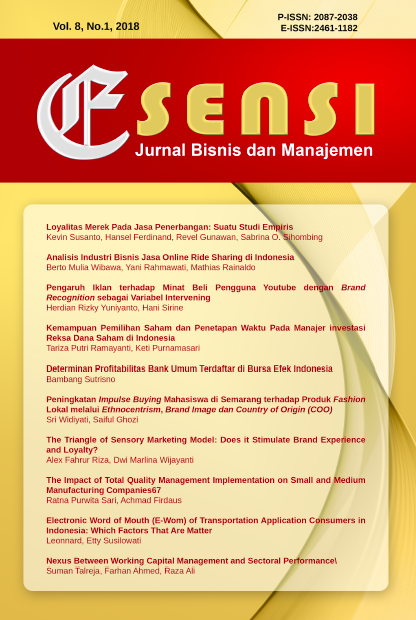Electronic Word of Mouth (E-Wom) of Transportation Application Consumers in Indonesia: Which Factors That Are Matter
DOI:
https://doi.org/10.15408/ess.v8i1.6708Keywords:
electronic word of mouth, transportation application, satisfactionAbstract
Transportation applications are now becoming a popular means of transportation in major cities of developing countries. This is because high levels of community mobility are faced with high levels of congestion. This study was constructed to test the effect of service quality to e-WOM through consumer satisfaction by using PLS SEM-path modeling. Empirical findings indicated that all hypotheses tested are proven. Service quality had a significant positive effect directly on satisfaction and indirectly against e-WOM. Subsequently, from the service quality indicator, the most influential indicator was the driver interaction with the consumer. These findings were different from public transportation, which did not employ online application where indicator tangibles had the highest effect that create consumer perception of service quality. Discussion and managerial implications are provided.
References
Abubakar, A. M., Ilkan, M., Al-Tal, R. M., & Eluwole, K. K. (2017). eWOM, revisit intention, destination trust and gender. Journal of Hospitality and Tourism Management. Vol. 31: 220-227.
Arndt, J. (1967). Role of Product-related Conversations in The Diffusion of a New Product. Journal of marketing Research. Vol. 4 (3): 291-295.
Carreira, R., Patrício, L., Jorge, R. N., Magee, C., & Hommes, Q. V. E. (2013). Towards a holistic approach to the travel experience: a qualitative study of bus transportation. Transport Policy. Vol. 25: 233-243.
Chou, P. F., Lu, C. S., & Chang, Y. H. (2014). Effects of service quality and customer satisfaction on customer loyalty in high-speed rail services in Taiwan. Transportmetrica A: Transport Science. Vol. 10(10): 917-945.
Duan, W., Gu, B., & Whinston, A. B. (2008). Do online reviews matter?—An empirical investigation of panel data. Decision support systems. Vol. 45(4): 1007-1016.
Fornell, C., & Larcker, D. F. (1981). Evaluating Structural Equation Models with Unobservable Variables and Measurement Error. Journal of Marketing Research. Vol. 18(1):39-50.
Gupta, H. (2017). Evaluating Service Quality of Airline Industry Using Hybrid Best Worst Method and VIKOR. Journal of Air Transport Management. doi: https://doi.org/10.1016/j.jairtraman.2017.06.001.
Hosseini, S. Y., Zadeh, M. B., & Bideh, A. Z. (2013). Providing a Multidimensional Measurement Model for Assessing Mobile Telecommunication Service Quality (MS-qual). Iranian Journal of Management Studies. Vol. 6(2): 71-80.
Hennig-Thurau, T., Gwinner, K. P., Walsh, G., & Gremler, D. D. (2004). Electronic Word-of-Mouth via Consumer-Opinion Platforms: What Motivates Consumers to Articulate Themselves on The Internet?. Journal of Interactive Marketing. Vol. 18(1): 38-52.
Hutchinson, J., Lai, F., & Wang, Y. (2009). Understanding The Relationships of Quality, Value, Equity, Satisfaction, and Behavioral Intentions Among Golf Travelers. Tourism management. Vol. 30(2): 298-308.
Jiang, H., & Zhang, Y. (2016). An Investigation of Service Quality, Customer Satisfaction and Loyalty in China's Airline Market. Journal of Air Transport Management. Vol. 57: 80-88.
Kim, S., Kandampully, J., & Bilgihan, A. (2018). The Influence of eWOM Communications: An Application of Online Social Network Framework. Computers in Human Behavior. Vol. 80: 243-254. doi: https://doi.org/10.1016/j.chb.2017.11.015.
Ladhari, R., & Michaud, M. (2015). eWOM effects on hotel booking intentions, attitudes, trust, and website perceptions. International Journal of Hospitality Management. Vol. 46: 36-45.
Lai, W. T., & Chen, C. F. (2011). Behavioral intentions of public transit passengers—The roles of service quality, perceived value, satisfaction and involvement. Transport Policy. Vol. 18(2): 318-325.
Leonnard., Daryanto, H. K., Sukandar, D., & Yusuf, E. Z. (2013). The Loyalty Model of Private University Student, Study Case: Stikom London School of Public Relation. International Journal of Information Technology and Business Management. Vol. 20(1): 91-100.
Leonnard., Daryanto, H. K., Sukandar, D., & Yusuf, E. Z. (2015). The Loyalty Model of Private University Student. International Research Journal of Business Studies. Vol. 7(1): 55-68.
Leong, L. Y., Hew, T. S., Lee, V. H., & Ooi, K. B. (2015). An SEM–Artificial-Neural-Network Analysis of The Relationships Between SERVPERF, Customer Satisfaction and Loyalty Among Low-cost and Full-service Airline. Expert Systems with Applications. Vol. 42(19): 6620-6634.
Li, C., & Wang, X. (2013). The Power of E-WOM: A Re-examination of Online Student Evaluations of Their Professors. Computers in Human Behavior. Vol. 29(4): 1350-1357.
Luo, Q., & Zhong, D. (2015). Using Social Network Analysis to Explain Communication Characteristics of Travel-related Electronic wWord-of-mouth on Social Networking Sites. Tourism Management. Vol. 46: 274-282.
Mahmoud, M., & Hine, J. (2016). Measuring the Influence of Bus Service Quality on The Perception of Users. Transportation Planning and Technology. Vol. 39(3): 284-299.
Öğüt, H., & Onur Taş, B. K. (2012). The influence of internet customer reviews on the online sales and prices in hotel industry. The Service Industries Journal. Vol. 32(2): 197-214.
Parasuraman, A., Zeithaml, V. A., & Berry, L. L. (1988). Servqual: A Multiple-item Scale for Measuring Consumer Perception. Journal of retailing. Vol. 64(1): 12 - 30.
Ratanavaraha, V., Jomnonkwao, S., Khampirat, B., Watthanaklang, D., & Iamtrakul, P. (2016). The Complex Relationship Between School Policy, Service Quality, Satisfaction, and Loyalty for Educational Tour Bus Services: A Multilevel Modeling Approach. Transport Policy. Vol. 45: 116-126.
Reimer, T., & Benkenstein, M. (2016). When good WOM hurts and bad WOM gains: The effect of untrustworthy online reviews. Journal of Business Research. Vol. 69(12): 5993-6001.

